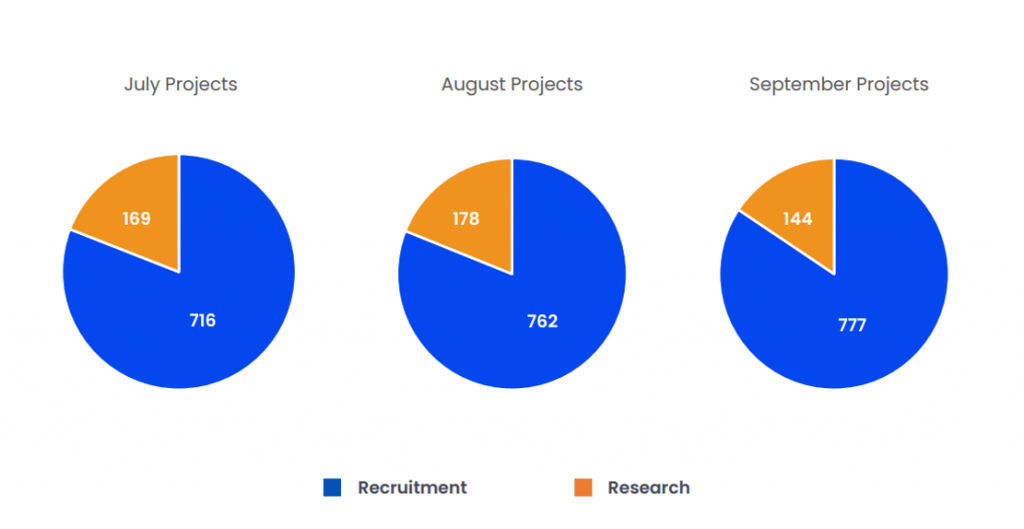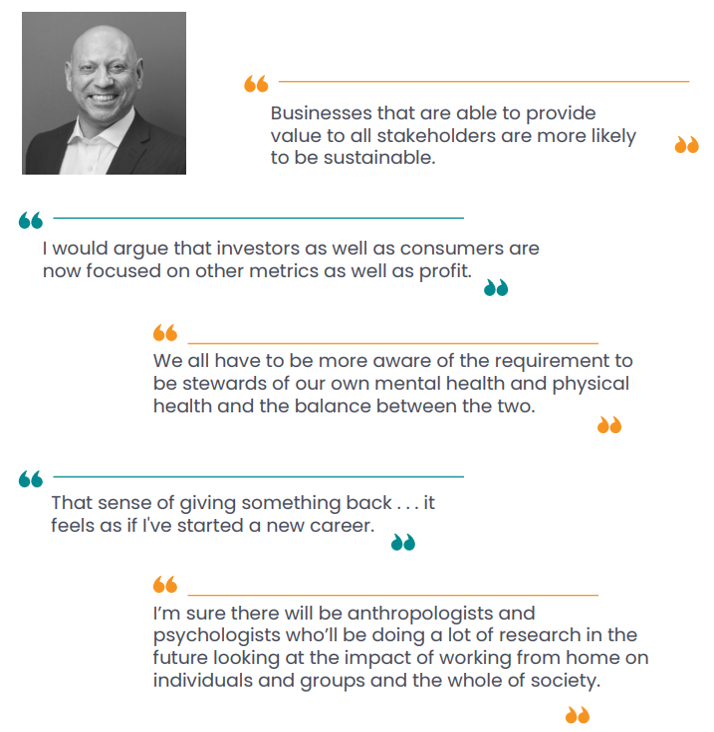A quarterly digest of facts, figures, and opinions from the Talent Acquisition Sector
October 2023

Money’s too tight to mention
How to find out what candidates are really earning
I was once at a dinner party where one
guest asked another how much money he
earned. An eerie silence descended as
conversations halted and everyone stared
at the floor. Our hostess ran off to the
kitchen, murmuring something about
coffee spoons. Now, this might just be a
British thing (the party was in London) but
it’s safe to say that most people in the
developed world have a similar antipathy
to talking about the very thing that makes
our whole culture go round . . . cash
This presents something of a problem for
hiring managers. How do you know what
you should be paying your staff if
everyone is so squeamish about divulging
their own remuneration? Of course, there
are salary surveys but even the supposed
best of these are often hopelessly
out-of-date or just plain wrong.
And even when they’re right, they’re only
ever a snapshot in time. That is, they tell
you what a candidate earns today. If
you’re looking to hire that candidate, the
more pertinent data point is what they
want to earn tomorrow.
So what’s the solution?
Let’s return to our crass dinner party guest.
Unsurprisingly, he didn’t get an answer to
his question. But suppose he’d known the
person he was addressing slightly better.
Suppose also he’d asked the question in
private, explaining that he needed the
information for some plausible
professional purpose.
At WhiteCrow Research, that’s pretty much
what we do. We pick up the telephone and
we talk to people. Lots of them. And
because we’re well practiced in gaining
sources’ confidence and trust, we almost
always get answers to our questions.
Our salary surveys don’t have hundreds of
data points. But they have enough. And
because they’re sourced from real people
in real roles, all the information is
completely accurate and up-to-date.
That’s how we know a lot of the better
known surveys (often from top consulting
brands) are somewhat reliable.
Money too tight to mention? Depends how
you ask the question…
The World According to WhiteCrow
As the world’s largest sourcing and recruitment company, WhiteCrow works with clients
across multiple geographies and sectors. So a brief glance at what we’re working on
ought to provide a clue to what’s going on in the wider market . . .
Last quarter, we wrote about Germany
slipping into recession and a number of
other countries performing sluggishly at
best; we wouldn’t say the world has
changed dramatically in the last three
months, but there are certainly reasons to
be slightly more cheerful.
Importantly, inflation is inching down
across parts of Europe and Asia, easing
the pressure on borrowing and keeping
some regions from the dreaded two
consecutive quarters of negative growth.
True, the US inflation rate nudged up half
a percentage point in August but globally
speaking the mood of employers seems
to be cautiously optimistic.
This is reflected in our project statistics. In
total, we worked on 2,746 projects in Q3,
338 more than last quarter. August
was our best month, with 178 research
projects and 762 recruitment projects. In
September, we slipped back very slightly
in terms of total projects but actually
worked on more recruitment projects
(777).That in itself is a promising sign
because it shows clients are hiring
instead of merely talent pipelining.
Even better, the uptick in client activity
seems to be true of many sectors.
Most quarters, we can tell from our
project sheet which areas of the
economy are performing best; this
month, it’s not so easy to figure out.
Perhaps it’s a case of all boats being
lifted on a rising tide.


In Conversation with . . .
The WhiteCrow Whisper recently sat down with JOHN ZAFAR, Chair of Inclusive
Employers (among other roles) and a veteran of the recruitment industry. John’s
insights into inclusion, corporate purpose, remote working and plenty of other issues
are well worth reading, so look out for the full interview on our website. Meanwhile,
here are a few of our favourite words of wisdom:

Talentomics
Covid. Cost of living. Ukraine. Whatever your view on the big issues of the day, we can all
agree these are unpredictable times. That’s a nightmare for workforce planning. So now
more than ever Talent teams need to be across the numbers. Below, we share a
selection of economic charts and comment briefly on their implications for recruitment.

In the UK, more workers are taking sick
days than at any time during the last
ten years; of more concern is the fact
that lots of those lost days are due to
mental health issues.
Reports suggest employee absence
is creeping up in in Europe and the US
as well, so it’s not surprising that health
spending across the world (see our
graph) has skyrocketed in the
last decade.
This is all something of a perfect storm:
falling productivity (because of
increased sickness) and rising health
costs are not a great combination; and
with no easy answers to the mental
health epidemic, the situation is likely to
get worse before it gets better.
It certainly behooves every business to do
what it can to help its employees stay
healthy, happy and productive.

A leading travel search engine has
ranked the top 100 countries for remote
working.
Kayak awards its number one spot to
Portugal, with the other top ten places
being an intriguing mix of Asian and Latin
American and European locations.
Countries were ranked according to a
range of metrics including safety,
climate, accessibility, internet speeds
and availability of co-working spaces.
This is probably a takeaway for
candidates rather than employers, but
talent professionals should also take
note: next time you’re looking for a
contract software engineer or a
freelance graphic designer, it’s worth
prioritising your search around the more
desirable work-from-home locations.
That, presumably, is where the major
talent pools will be.

A local council in the UK has been
accused of tampering with a report
on a four-day working week trial;
allegedly, South Cambridgeshire
District Council downplayed
participants’ concerns and deleted
negative comments, thus making
the outcome of the trial seem more
positive than it really was.
But there are plenty of other trials
(presumably not tampered with)
which seem to suggest workforces
are, paradoxically, more productive
when they work fewer hours.
Let’s hope that’s right because
among the countries currently trialing
or operating a four-day week are
some which already have some of the
shortest average working hours in the
world. One of the most enthusiastic
advocates for a four-day-week is
Belgium but this is a country which, as
our graph shows, makes relatively
easy demands upon its workforce.
Still, let’s give the four-day-week
advocates the final word: Belgian
workers also contribute $86.80 to
national GDP per hour worked, making
the country the tenth-most
productive in the world.
Quote of the Quarter

So mused a senior leader at a
well-known global tech firm. He was
referring of course to remote working.
Like a number of high profile businesses,
his employer is now insisting that
everyone returns to the office five days a
week. Among the perceived pitfalls of
the great work-from-home experiment,
our source cited loss of productivity,
poor communication, diminishing
employee loyalty, lack of training and an
erosion of company culture. Of course,
not everyone would agree and plenty of
companies are persevering with a flexible
working culture. But what’s most interesting
is that our source said his company’s
return-to-the-office directive received very
little pushback from younger employees. A
few years ago, this was the very group most
likely to be advocating for flexible working,
but now it seems they’re rapidly going off
the idea. A case, perhaps, of careful what
you wish for.

Wordplay
Like any industry, recruitment has its own lexicon of odd words and phrases. The best of
these serve to illuminate complex topics; the worst merely confuse and obfuscate.
As for the rest, well, let’s take a closer look…


Give someone an award and a
microphone and chances are they’ll
inform the assembled masses they are
“humbled”. They might pronounce
themselves “truly” or “profoundly”
humbled. Perhaps they’ll place their hand
over their heart to indicate just how very
humbled they are. All of which makes very
little sense. Surely most people being
loudly applauded by a big crowd of
people would feel ever so slightly less
humble. In fact, they’d probably feel
pretty damned pleased with themselves.
So why do they say the opposite? It’s even
creeping into LinkedIn posts nowadays
with employees professing themselves
“humbled” to be promoted or offered a
new job. We understand they might feel
“honoured” or “delighted” or even
“overwhelmed”. But humbled?
What we’re seeing here is a pandemic of
so-called ‘humblebrag’; i.e. the practice
of boasting about yourself while actually
seeming to do the reverse. In short, what
‘humbled’ means is this: not only has this
amazing thing happened to me, but I’m
also really down-to-earth about it. Well,
to be fair, that’s what it used to mean.
Now people say ‘humbled’ because that’s
what everyone else says. About time we
all stopped.
Contact
To discuss any of the issues raised in this month’s newsletter or to explore how
WhiteCrow Research can help with any of your talent insight and recruitment
needs, please contact us.



